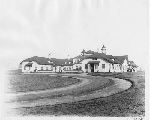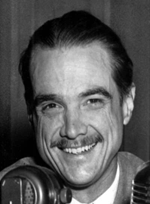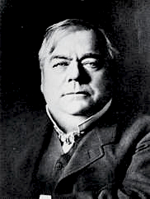Fifth District Captains of Industry
R.A. Long Lee's Summit , Missouri
Longview Farm was the country estate of  Kansas City lumber R.A. Long baron and philanthropist, R.A. Long (left) (1850–1934). Long’s city home was Corinthian Hall, now the Kansas City Museum. He also built the city’s first skyscraper, the R.A. Long Building, at 10th & Grand as headquarters for his Long-Bell Lumber Co. As a leading philanthropist, Long spearheaded the drive to build the Liberty Memorial after World War I.
Kansas City lumber R.A. Long baron and philanthropist, R.A. Long (left) (1850–1934). Long’s city home was Corinthian Hall, now the Kansas City Museum. He also built the city’s first skyscraper, the R.A. Long Building, at 10th & Grand as headquarters for his Long-Bell Lumber Co. As a leading philanthropist, Long spearheaded the drive to build the Liberty Memorial after World War I.
Longview Mansion and 50 other farm structures were constructed in just 18 months between 1913 and June 1, 1914. More than 50 Belgian craftsmen and 200 Sicilian stonemasons were among the 2,000 workers employed to turn 1,780 raw acres into “The World’s Most Beautiful Farm.”
among the 2,000 workers employed to turn 1,780 raw acres into “The World’s Most Beautiful Farm.”
Loula Long CombsLong’s daughter, Loula (left)(1881–1971) and her husband Robert Pryor Combs lived at Longview. For 65 years she competed in and won international horse shows in New York, Canada and England. She became known as the Queen of the American Royal and is in the Madison Square Garden Hall of Fame. All of her prize-winning horses were raised and trained at Longview Farm, including her favorite, Revelation, whose grave marker is in front of the Show Horse Arena.
The farm employed 175 people. Besides horses, Longview was known for its pure bred Jersey dairy cattle that provided milk for Long’s family, his employees and area charities. Longview Farm’s greenhouses produced prize-winning roses and other flowers.
provided milk for Long’s family, his employees and area charities. Longview Farm’s greenhouses produced prize-winning roses and other flowers.
Toward the end of their lives, Loula and her sister Sally America Long Ellis donated the land for Longview Community College. Other parcels were sold and became Longview Lake and nearby residential communities.
Howard Hughes and KC's Connie
Though known for the “Spirit of St. Louis,” Charles A. Lindbergh also  sparked Kansas City’s spirit of aviation. Lindbergh flew in and out of Kansas City frequently, and had trained at Richards Field in 1925. On August 17, 1927, just three months after his transatlantic flight, Lindbergh flew in to dedicate Kansas City’s new downtown airport where he was greeted by a crowd of 10,000 admirers. Festivities included a speech, parade, and a banquet at the Hotel President.
sparked Kansas City’s spirit of aviation. Lindbergh flew in and out of Kansas City frequently, and had trained at Richards Field in 1925. On August 17, 1927, just three months after his transatlantic flight, Lindbergh flew in to dedicate Kansas City’s new downtown airport where he was greeted by a crowd of 10,000 admirers. Festivities included a speech, parade, and a banquet at the Hotel President.
Two years later, Lindbergh helped convince Transcontinental Air Transport—which became TWA—to make Kansas City its world headquarters. By the early ‘30s, Kansas City would become the overnight stop on the nation’s first regular coast-to-coast air service, and—as shown in this letter from Lindbergh to Lou Holland—become one of the nation’s air centers.
Transcontinental Air Transport opened their international headquarters in Kansas City in 1929. In July of that year the company launched its first coast-to-coast route service. Lindbergh, a technical advisor for T.A.T. (Amelia Earhart served as assistant to the general manager), designed the route, in which passengers took a train from New York to Port Columbus, Ohio; flew to Waynoka, Oklahoma; took another train to Clovis, New Mexico; and flew the final leg to Los Angeles. The trip took 48 hours and cost $351 one way.
In 1939, Hughes' fame and fortune caught the attention of Jack Howard HughesFrye, the president of TWA. Frye was bitterly feuding with board members who were against new plane purchases. At Frye's urging, Hughesquietly bought up a majority of TWA stock and took over the company. Now that Hughes owned TWA, federal law prohibited him from building his own planes. Seeking a plane which could perform better than TWA's current fleet of Boeing Stratoliners, Hughes approached Boeing's competitor, Lockheed. He already had established a good relationship with the manufacturer, since it had built the plane Hughes used in his record flight around the world. Lockheed agreed to Hughes' demand that the plane be built in absolute secrecy. The end result was the revolutionary new plane, the Constellation. The Constellation's pressurized cabin allowed the plane to fly at greater altitudes, enabling the plane to fly above most air turbulence, thus providing passengers with a more comfortable flying experience. The rarefied air at that altitude also cuts down on drag, enabling the plane to cruise at the incredible speed of 280 miles per hour - dramatically faster than its competitors.
Constellation. The Constellation's pressurized cabin allowed the plane to fly at greater altitudes, enabling the plane to fly above most air turbulence, thus providing passengers with a more comfortable flying experience. The rarefied air at that altitude also cuts down on drag, enabling the plane to cruise at the incredible speed of 280 miles per hour - dramatically faster than its competitors.
Over the next decade, Hughes and TWA would profit from the tremendous success of the Constellation, and its successor, the Super Constellation.
A fully resorred Constellation or "Connie" can be seen at the Airline History Museum is located at the Historic Charles Wheeler Downtown Airport, in Kansas City, Missouri. To walk through it is to truly step back in time, to a different and more graceful age of air transportation. The museum contains a collection of photographs, artifacts, printed material, and audio/visual displays that will bring you the true flavor of an age gone by. Uniforms, galley items, instrumentation, logbooks, personal mementos, and so much more to bring to life the propeller-driven era. Then there is our aircraft collection which includes the Queen of our fleet, the Lockheed L1049 "Super G" Constellation, a Martin 404, and a Douglas DC-3, which is undergoing restoration.
Hours of operation are Monday through Saturday, 10am to 4pm, and Sunday, 12pm to 4pm. Admission to the Museum and to tour the aircraft is $7.00 for age 14 and over, $6.00 for age 65 and over, $3.00 for ages 6-13.
Children under 6 are free with a paid adult admission.
Special thanks to the Airline History Museum and the PBS series "Chasing the Sun" for contributing to this page.
William Rockhill Nelson
Kansas City, Missouri
The Kansas City Star was founded Sept. 18, 1880, by William Rockhill Nelson, an Indianan who had run a construction business, gambled and lost in commodities and, before heading west, owned the Fort Wayne Sentinel. At Nelson's side was Samuel Morss, a veteran newspaperman who had helped Nelson establish the Sentinel as a vigorous proponent of civic reform.
Nelson, an Indianan who had run a construction business, gambled and lost in commodities and, before heading west, owned the Fort Wayne Sentinel. At Nelson's side was Samuel Morss, a veteran newspaperman who had helped Nelson establish the Sentinel as a vigorous proponent of civic reform.
The Star faced competition from two morning papers, The Times and The Journal, and an afternoon daily, The Mail, each priced a nickel a copy. The fledgling evening Star set its price at 2 cents a copy and set its editorial policy to cover local events intensely. In the late 19th century, Kansas City had few paved streets and few sidewalks. Mud and horse manure were everywhere. Nelson, a public-works contractor for part of his career in Indiana, used The Star to campaign for paved roads and streets, first in the Bottoms and Downtown and later elsewhere. Also, he crusaded for improved sidewalks and sewers, decent public buildings, better streetlights, and more fire and police protection. His most enduring legacy was the city's park system, which he began promoting in 1881 along with August Meyer, a wealthy real estate man.
The origin of The Nelson-Atkins Museum of Art in Kansas City, Missouri, can be traced to Nelson’s dissatisfaction with Kansas City. Nelson thought the city was “incredibly commonplace and ugly. I decided that if I were to live here, the town must be made over.” When he died in 1915, his will provided that when his wife and daughter died, all the proceeds of his estate were to be used for “the purchase of works of art and reproductions of works of the fine arts, such as paintings, engravings, sculpture, tapestries and rare books…which will contribute to the delectation and enjoyment of the public generally."
Missouri, can be traced to Nelson’s dissatisfaction with Kansas City. Nelson thought the city was “incredibly commonplace and ugly. I decided that if I were to live here, the town must be made over.” When he died in 1915, his will provided that when his wife and daughter died, all the proceeds of his estate were to be used for “the purchase of works of art and reproductions of works of the fine arts, such as paintings, engravings, sculpture, tapestries and rare books…which will contribute to the delectation and enjoyment of the public generally."
The first problem was the lack of a museum building. Nelson had erroneously assumed the city would provide it. Fortunately Mary Nelson Atkin Museum of Art postcardAtkins, a reclusive former school teacher who developed an appreciation for fine art late in life, willed $300,000 to Kansas City for the establishment of an art museum. The trustees of her estate combined its assets with funds bequeathed by Nelson’s widow and daughter, his son-in-law, Irwin Kirkwood, and an attorney and family friend, Frank F. Rozzelle. Kirkwood also deeded the site of Oak Hall, Nelson’s home, to the city for an art museum, and ground was broken in 1930.
Unlike most great museums, the Nelson-Atkins was not built on existing collections of art. Laurence Sickman, the late director emeritus, said in 1983, “When the Nelson-Atkins started to build in 1930, it didn’t even own an etching. Practically all museums start with a nucleus of a collection, but there was none in Kansas City. So the trustees had to start buying."
That apparent disadvantage proved to be an enviable stroke of good fortune. At the depths of the Depression, the new museum was in a buyer’s market, armed with plenty of money. The Museum’s buyers were able to procure excellent pieces at relatively low prices. The Museum also was fortunate to find Sickman, who at the time was a Harvard-Yenching fellow in China. He was hired to purchase Asian art for the Nelson-Atkins, and he was able to find art treasures at their source, thereby acquiring art at much lower prices and expediting shipping. Much more important, however, was Sickman’s gift of connoisseurship. As John Russell, art critic for The New York Times said in 1983, “It is difficult not to regard (the Chinese galleries) as one of the finest single curatorial achievements in museum history.”
Today, the Asian collection is recognized as one of the country’s finest. It includes art from China, Japan, India, Iran, Indonesia, Korea, and Southeast and South Asia. The large collections of Chinese paintings and furniture are considered especially fine.
The European painting collection at the Nelson-Atkins also is particularly notable. It includes masterpieces from a wide spectrum of periods and countries by such artists as Claude Monet, Edgar Degas, Vincent van Gogh, Jean Baptiste Siméon Chardin, Guercino, Titian, Caravaggio, Peter Paul Rubens and Rembrandt.
The American painting collection, through the Enid and Crosby Kemper Foundation, is home to important works by Thomas Eakins, John Singleton Copley, Winslow Homer, Frederic Church and John Singer Sargent. The American holdings also include the largest public collection of works by Missouri native Thomas Hart Benton and numerous works by Missourian George Caleb Bingham.
Special thanks to the Nelson-Atkins Museum of Art for contributing to this page. More on one of America's top ten galleries of art, the Nelson-Atkins, can be found at www.nelson-atkins.org

